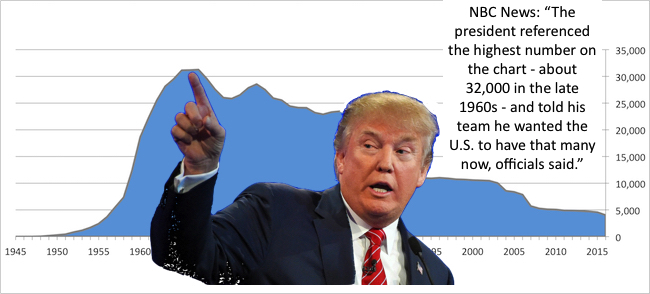‘Small Hands’ Don’t Like Small Nuclear Arsenals

By Hans M. Kristensen
According to an NBC News report, President Donald Trump said during a meeting at the Pentagon on July 20 that “he wanted what amounted to a nearly tenfold increase in the U.S. nuclear arsenal,” according to three officials who were in the room.
Trump’s statement came in response to a chart shown during the meeting on the history of the U.S. and Russia’s nuclear capabilities. Trump reportedly referenced the highest number on the chart – about 32,000 in the late 1960s – and “told his team he wanted the U.S. to have that many now, officials said.”
It is often a mystery how Trump reaches his conclusions and his statement about increasing the arsenal is clearly not based on rational reasoning or factual information. Presidential advisors at the meeting reportedly explained why an expansion was not feasible (that must have been an embarrassing moment) and officials said his comments “raised questions about his familiarity with the nuclear posture and other issues.”
Despite Trump’s fantasies, the United States is unlikely to increase its nuclear weapons stockpile. There are currently about 4,000 nuclear warheads in the Pentagon’s stockpile, of which roughly 1,800 are deployed on ballistic missiles and at bomber and fighter bases. The military says it has too many and could meet national and international commitments with up to one-third fewer deployed weapons. And the trend is that the stockpile will continue to decline over the next decade because of changes being made to the force structure as part of the current modernization program.
Fun facts added: The biggest stockpile increase in one year was 1959-1960 when the United States added 6,340 warheads. During the 72 years since the first production of nuclear weapons in 1945, the average number of nuclear weapons added to the U.S. stockpile per year is 56. At that rate, it would take 487 years to increase the stockpile to the peak of 31,255 warheads in 1967.
Yet Trump’s repeated statements demonstrate a predisposition toward more nuclear weapons. The big question is to what extent that will influence the Nuclear Posture Review (NPR) currently under preparation. Trump might try to slow the reduction and force the military to hang on to excess warheads even though they don’t need them or want them.
More likely is that Trump with the NPR will try to further increase the capabilities of the remaining weapon types. Again, enhancements are already being added as part of the ongoing modernization programs, but there are people involved in the NPR process that are advocating doing more. The White House apparently is in favor of researching and developing a ground-launched missile that, if tested and deployed, would violate the INF treaty (this is a Cold War tit-for-tat response to Russia’s violation of the treaty).
Despite current challenges to the international nuclear weapons arms control efforts, it is essential that the Trump administration reaffirms long-standing U.S. nuclear policy to reduce nuclear arsenals and work toward the eventual elimination of nuclear weapons. Doing otherwise might satisfy defense hawks with no gain for national security, but it would also embolden other nuclear-armed states to further increase their arsenals to the detriment of the security of the United States and its allies.
Background:
This publication was made possible by a grant from the Carnegie Corporation of New York, the New Land Foundation, and the Ploughshares Fund. The statements made and views expressed are solely the responsibility of the author.
The FY2026 National Defense Authorization Act (NDAA) paints a picture of a Congress that is working to both protect and accelerate nuclear modernization programs while simultaneously lacking trust in the Pentagon and the Department of Energy to execute them.
While advanced Chinese language proficiency and cultural familiarity remain irreplaceable skills, they are neither necessary nor sufficient for successful open-source analysis on China’s nuclear forces.
Satellite imagery has long served as a tool for observing on-the-ground activity worldwide, and offers especially valuable insights into the operation, development, and physical features related to nuclear technology.
This report outlines a framework relying on “Cooperative Technical Means” for effective arms control verification based on remote sensing, avoiding on-site inspections but maintaining a level of transparency that allows for immediate detection of changes in nuclear posture or a significant build-up above agreed limits.